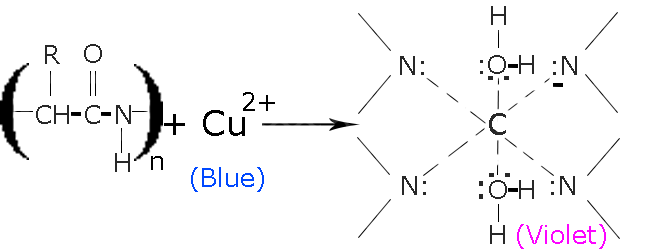
What is a Biuret test?
Answer
583.2k+ views
Hint: Before attempting this question, one must have prior knowledge of oxidation and reduction, and how it leads to change in color, especially in the case of $C{u^{2 \oplus }}$ and ion.
Complete answer:
> The Piotrowski’s test, or as it is more commonly known, Biuret test. This test is used, when we have to detect the presence of peptide bonds in an alkaline solution.
> Interestingly, the biuret test does not use the reagent biuret. Instead, it uses a mixture of sodium hydroxide and hydrated Copper (II) Sulfate$C{u^ \oplus }$ as reagents. Potassium Sodium Tartrate is also used to stabilize the chelate formed.\[C{u^{2 \oplus }}\]
> Reaction: In the presence of\[NaOH\], \[C{u^{2 \oplus }}\] from hydrated Copper (II) Sulfate$(CuS{O_4}.x{H_2}O)$ is released. Then combine with peptide molecules to form a chelate as shown below.

> The reaction occurs in two steps:-
1) Copper(II) binds with nitrogen, that are present in the protein’s peptide chains
2) In the 2nd step Copper (II) is reduced to Copper (I), which gives the solution its iconic light-purple color.
> The biuret solution is blue in color and turns light-purple, when it reacts with compounds containing peptide bonds.
> The biuret can also be used to measure the concentration of proteins, by using the Beer-Lambert law i.e. the intensity of the color (absorption of light at 540nm) is directly proportional to the protein concentration
Note: Buffers, like Ammonia interfere with the reaction, therefore this test is not suitable for protein samples purified from ammonia sulfate precipitation. The $NaOH$solution used should be concentrated and then followed by a few drops of hydrated Copper (II) Sulfate$(CuS{O_4}.x{H_2}O)$.
Complete answer:
> The Piotrowski’s test, or as it is more commonly known, Biuret test. This test is used, when we have to detect the presence of peptide bonds in an alkaline solution.
> Interestingly, the biuret test does not use the reagent biuret. Instead, it uses a mixture of sodium hydroxide and hydrated Copper (II) Sulfate$C{u^ \oplus }$ as reagents. Potassium Sodium Tartrate is also used to stabilize the chelate formed.\[C{u^{2 \oplus }}\]
> Reaction: In the presence of\[NaOH\], \[C{u^{2 \oplus }}\] from hydrated Copper (II) Sulfate$(CuS{O_4}.x{H_2}O)$ is released. Then combine with peptide molecules to form a chelate as shown below.

> The reaction occurs in two steps:-
1) Copper(II) binds with nitrogen, that are present in the protein’s peptide chains
2) In the 2nd step Copper (II) is reduced to Copper (I), which gives the solution its iconic light-purple color.
> The biuret solution is blue in color and turns light-purple, when it reacts with compounds containing peptide bonds.
> The biuret can also be used to measure the concentration of proteins, by using the Beer-Lambert law i.e. the intensity of the color (absorption of light at 540nm) is directly proportional to the protein concentration
Note: Buffers, like Ammonia interfere with the reaction, therefore this test is not suitable for protein samples purified from ammonia sulfate precipitation. The $NaOH$solution used should be concentrated and then followed by a few drops of hydrated Copper (II) Sulfate$(CuS{O_4}.x{H_2}O)$.
Recently Updated Pages
Why is there a time difference of about 5 hours between class 10 social science CBSE

In cricket, what is a "pink ball" primarily used for?

In cricket, what is the "new ball" phase?

In cricket, what is a "death over"?

What is the "Powerplay" in T20 cricket?

In cricket, what is a "super over"?

Trending doubts
What are the major means of transport Explain each class 12 social science CBSE

Which are the Top 10 Largest Countries of the World?

Draw a labelled sketch of the human eye class 12 physics CBSE

How much time does it take to bleed after eating p class 12 biology CBSE

Explain sex determination in humans with line diag class 12 biology CBSE

Explain sex determination in humans with the help of class 12 biology CBSE




